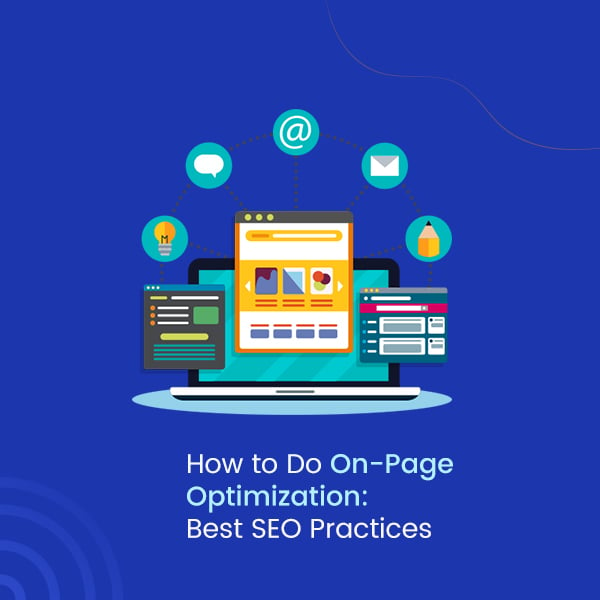
In what ways does On-Page SEO help?
On-page SEO (search engine optimization) is the technique of improving your site’s rankings and user experience by optimizing individual pages.
On-page SEO is essential since it informs Google about your website and how you deliver value to users and consumers. It allows you to optimize your website for both human visitors and search engine bots.
It’s not enough to just build and publish a website; you also need to optimize it for Google and other search engines in order to rank and attract new visitors.
The tweaks and improvements you make to optimize your website are apparent to visitors on your page (whereas off-page and technical SEO aspects aren’t always accessible).
Every aspect of on-page SEO is entirely up to you, which is why it’s so important to do it right. Let’s talk about the components of on-page SEO now.
On-page SEO Element are as follow :
- Page Content of the highest quality
- Titles tags
- Meta Descriptions
- Content with keyword words that are specifically targeted
- Keyword phrases and header tags
- Internal Linking
- Image ALT tags
- Site Speed
1. Page Content of the highest quality
The heart of on-page SEO is page content. It explains what your website and business are all about to both search engines and readers. Choosing relevant keywords and topic is the first step toward creating high-quality content. Search Google for phrases and see what comes up for competitors and other websites.
This isn’t a major ranking factor, but it will make it easier for your users to scan your material and locate the keywords they’re looking for. To distinguish words in the text, utilize bolding and bullet points, which also notifies the engines of what’s significant on the page. Don’t go overboard or you’ll wind up with a cluttered page that irritates the user.
2. Title tags
The title tag informs search engines about the page’s content and whether or not the page on your website is relevant for that keyword or phrase. Every page’s title tag should be unique. If a user has looked for those terms, search engines will highlight your keyword phrases in search results. This raises the prominence of the ad and the click-through rate.
Here are some step you should know for the Title tags and here they are as follow :
- Your title tag should be written in the following format: Primary Keyword – Secondary Keyword | Brand Name
- In between your keyword words, use a dash, and before your brand name, use a pipe.
- Avoid using the same title tag again.
3. Meta Descriptions
The short page descriptions that appear below the title in search results are known as meta descriptions. Although it isn’t a search engine’s official ranking criteria, it can have an impact on whether or not your page is clicked on, thus it’s just as crucial when doing on-page SEO.
Good meta descriptions include the following :
- Meta descriptions should be compelling.
- The recommended length is the 160 characters
- Avoid duplicating meta descriptions
- Google will automatically remove quotes and non-alpha characters from your meta description if you use them.
4. Content with keyword words that are specifically targeted
It is critical that your content be both unique and relevant. If you have numerous pages with the same material (or if your content appears on other people’s websites), you risk being penalized by Google, and your search rankings will suffer as a result.
Keep your material distinctive if you want to keep Google happy.
Here are some steps to follow :
- Produce material that is exceptionally related to the keyword phrase.
- Repeat your keyword term four times in your article (but not excessively).
- Include links from other pages within your website that point back to this page.
5. Keyword phrases and header tags
A header tag, commonly known as an H1 tag, is similar to your web page’s subject line. In the H1 element, you should only utilize your keyword phrase once. This should be on a page where you’re attempting to drive unique traffic. If there are numerous sections, you can also use H2 tags (second headers).
Here are some steps you should know :
- In your H1 tag, use your keyword phrase only once.
- On sites to which you want to draw unique traffic, use H1 tags (SEO page)
- If there are numerous sections, use H2 tags.
6. Internal Linking
The process of linking to other useful pages on your website is known as internal linking. Internal links are vital for on-page SEO because they direct visitors to other pages on your site, keeping them on your site longer and indicating to Google that your site is interesting and useful.
Additionally, the longer people stay on your website, the longer Google has to crawl and index your pages. This allows Google to gather more information about your website and, as a result, rank it higher on search engine results pages.
7. Image ALT tags
An image’s alt tag is essentially its name. Alt tags should be used for all photos. Alt tags are useful not only for search engines but also for accessibility. Those that use a screen reader will be able to hear what that image is.
Here are some steps you should know :
- Give each of your images a name that accurately conveys what they are.
- Use dashes instead of underscores between words (purple-hat.jpg rather than purple_hat.jpg).
- Do not use non-alpha characters in the name of your image or file (no %, &, $, etc…)
8. Site Speed
Your site must load rapidly whether it is visited on a mobile device or a desktop computer. Page speed is extremely important when it comes to on-page SEO.
First and foremost, Google is concerned about the user experience. Your visitors are likely to linger around if your site loads slowly or clumsily.